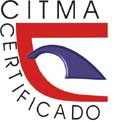Characterization of an industrial calcium hydroxide residue generated in acetylene manufacturing process
Keywords:
acetylene residual , granulometry , calcium hydroxide, neutralizationAbstract
The purpose of the work is to characterize, from the chemical, physical, granulometric and mineralogical point of view, an industrial residue of calcium hydroxide generated in the acetylene manufacturing process. Samples were first analyzed without neutralization; then the same procedure was performed using 98 % purity sulphuric acid. For both cases, the heating temperatures used were 500 °C and 900 °C. To identify the phases, diffraction patterns were obtained using copper radiation source (CuKα, λ = 1.5418 Å). It was determined that residual contains CaO and MgO, which guarantees its purity; heated at 500 °C, and without neutralizing, calcium hydroxide is transformed and there is loss of water and carbonate at 900 °C. In both untreated and neutralized waste, Calcium hydroxide is present.Downloads
References
Álvarez, J. (2014). Cieno de acetileno. Un hidrato de cal económico para morteros de albañilería. Décima Conferencia Científico-Técnica de la Construcción, Cuba.
Baglioni, P., Chelazzi, D., Giorgi, R., Carretti, E., Toccafondi, N. & Jaidar, Y. (2014). Commercial Ca(OH)2 nanoparticles for the consolidation of immovable works of art. Applied Physics A, 114, 723-732. http://link.springer.com/article/10/.1007/s00339-013-7942-6
Fava, L. & Saunders, W. (1999). Calcium hydroxide pastes: classification and clinical indications. International Endodontic Jornal, 32(4), 257-822. https://doi.org/10.1046/j.1365-2591.1999.00232x
Giorgi, R., Ambrosi, M., Toccafondi, N. & Baglioni, P. (2010). Nanoparticles for cultural heritage conservation: Calcium and barium hydroxide nanoparticles for wall painting consolidation. Chemistry_A European Journal, 16(31), 9374-9382. https://chemistry-europe.onlinelibrary.wiley.com/doi/abs/10.1002/chem.201001443
Henderson, M., Keith, D., Pal-Singh-Kainth, A., Heidel, K. & Ritchie, J. A. (2014). U.S. Patent No. 8,871,008. Washington, DC:U.S Patent and Trademark Office. https://patents.google.com/patent/US8871008/en
Irimia-Vladu, M. (2014). Green electronics: Biodegradale and biocompatible materials and devices for sustainable future. Chemistry Society Reviews, 43(2), 588-610. https://pubs.rsc.org/en/content/articlehtml/2014/cs/c3cs69235d
Kum, C., Cho, Y., Joung, Y., Choi, J., Park, K., Seo, S.H. & Han, D.K (2013). Biodegradable poly(L-lactide) composites by oligolactide-grafted magnesium hydroxide for mechanical reinforcement and reduced inflammation. Journal of Materials Chemistry B, 1(21), 2764-2772. https://pubs.rsc.org/en/content/articlelanding/2013/tb/c3tb00490b/unauth
Lewis, D., Kevin, P., Bakr, O., Muryn, C.A., Malik, M.A. & O´Brien, P. (2014). Routes to tin chalcogenide materials as thin films or nanoparticles: a potentially important class of semiconductor for sustainable solar energy conversion. Inorganic Chemistry Frontiers, 1(8), 577-598. https://pubs.rsc.org/en/content/articlehtml/2014/qi/c4qi00059e
Norma Cubana 54-286. (1984). Materiales y productos de la construcción. Hidrato de cal. Especificaciones de calidad
Norma Cubana 178. (2002). Análisis granulométrico. https://ftp.isdi.co.cu/Biblioteca/BIBLIOTECA UNIVERSITARIA DEL ISDI/COLECCION DIGITAL DE NORMAS CUBANAS/2002
Norma Cubana 186. (2002). Arena. Peso específico y absorción de agua. Método de ensayo. https://ftp.isdi.co.cu/Biblioteca/BIBLIOTECA UNIVERSITARIA DEL ISDI/COLECCION DIGITAL DE NORMAS CUBANAS/2002
Poggi, G., Toccafondi, N., Chelazzi, D., Canton, P. Giorgi, R., & Baglioni, P. (2016). Calcium hydroxide nanoparticles from solvothermal reaction for the deacidification of degraded waterlogged wood. Journal of Colloid Interface Science, 473, 1-8. https://pubmed.ncbi.nlm.nih.gov/27042819/
Published
How to Cite
Issue
Section
Copyright (c) 2024 Yoel Ochoa-Mc-Intosh, Tomás Hernaldo Fernández-Columbié, Ledennis Suárez-Torres, Isnel Rodríguez-González, Elís E. Guzmán-Romero

This work is licensed under a Creative Commons Attribution-NonCommercial 4.0 International License.
- Authors retain copyright and guaranteeing the right magazine to be the first publication of the work as licensed under a Creative Commons Attribution-NonCommercial that allows others to share the work with an acknowledgment of the work's authorship and initial publication in this journal.
- Authors may establish separate supplemental agreements for the exclusive distribution version of the work published in the journal (eg, place it in an institutional repository or publish it in a book), with an acknowledgment of its initial publication in this journal.
- Authors are allowed and recommended to disseminate their work through the Internet (e.g., in institutional telematic archives or on their websites) before and during the submission process, which can produce interesting exchanges and increase citations of the published work. (See The effect of open access)



